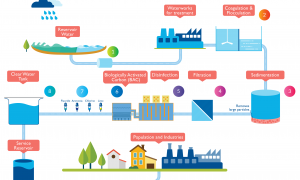🕑 Reading time: 1 minute
Contents:
Analysis of Rainfall Data
Before using rainfall records at a station for any analysis, the data has to be checked for- Continuity
- Consistency
Estimation of Missing Rainfall Data
Required to find the missing annual precipitation
Test for Consistency of Record
Inconsistency would arise in the rainfall data at a raingauge station if conditions relevant to recording of rainfall at the station undergoes significant change during the period of record. It would be felt from the time a significant change took place. Some common causes for inconsistency of record- Shifting of the raingauge to a new location
- Neighbourhood of the station is undergoing significant changes
- Change in the ecosystem due to natural calamities such as forest fires, landslides etc
- Errors in observation from a certain date
- Let X be the station where inconsistency in rainfall records is observed.
- Select a group of about 5 to 10 base stations in the neighbourhood of station X.
- Data of annual or monthly mean rainfall of station X as well as the average rainfall of the group of base stations over a long time period is arranged in reverse chronological order ie. the latest record is the first entry and the oldest record is the last entry in the list.
- Accumulated precipitation at station X
 and the accumulated values of the average precipitation of the group of base stations
and the accumulated values of the average precipitation of the group of base stations are computed from the latest records.
are computed from the latest records. - A plot of
![clip_image006[1] clip_image006[1]](data:image/gif;base64,R0lGODlhAQABAAAAACH5BAEKAAEALAAAAAABAAEAAAICTAEAOw==) vs
vs ![clip_image007[1] clip_image007[1]](data:image/gif;base64,R0lGODlhAQABAAAAACH5BAEKAAEALAAAAAABAAEAAAICTAEAOw==) for various consecutive time periods is prepared.
for various consecutive time periods is prepared. - A break in the slope of this plot indicates a change in the precipitation regime of station X.
- Precipitation values at X beyond the period of change of regime is corrected as


Figure: Double mass curve
Thus older records are brought to the new regime at X.- The more homogeneous the base station records are, the more accurate will be the corrected values at station X.
- A change in slope is taken as significant only if it persists for more than 5 years.
- The double mass curve technique is also useful in checking arithmetical errors in transferring rainfall data from one record to another.
Presentation of Rainfall Data
Mass Curve of Rainfall
- It is a plot of accumulated precipitation against time, plotted in chronological order.
- Records of float type, weighing bucket type etc raingauges are of this form.
- It gives information on duration and magnitude of a storm.Intensity at various time intervals in a storm = slope of the curve.
- It can be prepared for non-recording raingauges also if the approximate start and end of a storm are known.

Figure: Mass curve of rainfall
Hyetograph
- It is a plot of rainfall intensity against time interval.
- Time interval depends on the purpose (urban drainage problems – small durations, flood flow computations from large catchments~ 6h).
- It can be derived from the mass curve of rainfall.
- It is represented as a bar chart.
- It is useful in developing design storms to predict extreme floods.
- Area under a hyetograph = total precipitation received in that time period.

Figure: Hyetograph of a storm


